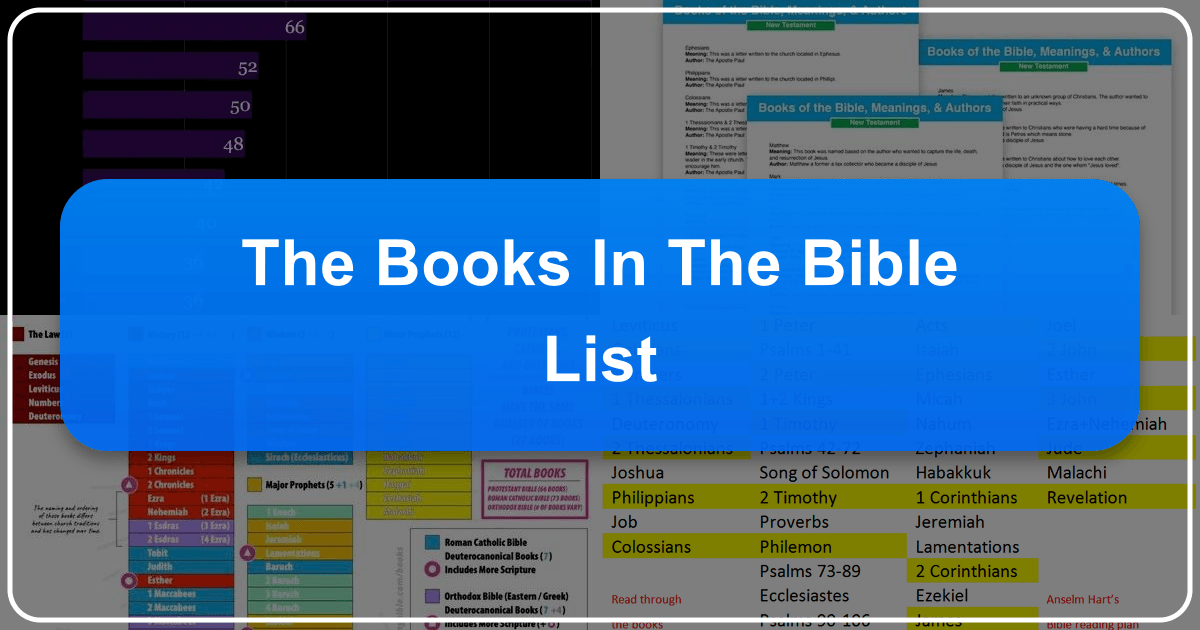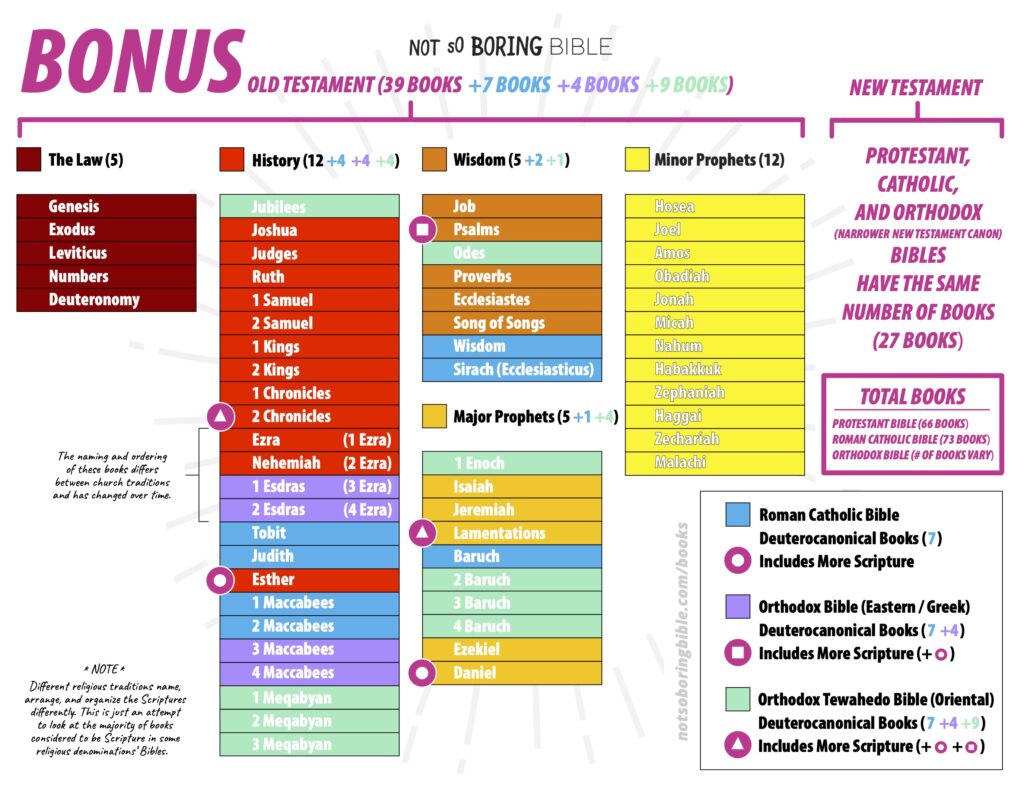The 66 Books of the Bible: A Comprehensive Guide

Navigating the world of the Bible can feel like entering a vast and ancient library, filled with diverse texts spanning centuries and cultures. This guide aims to illuminate the 66 books that comprise the Christian Bible, offering a structured exploration of their contents, authorship, historical context, and lasting influence. We will move beyond a simple chronological listing, categorizing the books by genre and exploring their unique contributions to the larger narrative.
The Old Testament: Foundations and History
The Old Testament, also known as the Hebrew Bible, forms the foundational bedrock of the Judeo-Christian tradition. Its 39 books chronicle the unfolding story of God’s covenant with humanity, beginning with creation and extending through the rise and fall of kingdoms. While traditionally attributed to specific authors, modern scholarship often acknowledges multiple authors and redactors involved in shaping these texts over time. Our summaries will approach each book objectively, presenting the narrative content without necessarily endorsing traditional authorship claims or historical interpretations debated by contemporary scholarship.

The Pentateuch: The Law
The first five books, collectively known as the Torah or Pentateuch, establish the foundation of Jewish law and Israelite identity.
1. Genesis: Genesis recounts the creation of the world, the fall of humanity, and the early patriarchal narratives focusing on figures such as Adam, Eve, Noah, Abraham, Isaac, Jacob, and Joseph. The book culminates with the Israelites’ descent into slavery in Egypt, setting the stage for the events of Exodus.
2. Exodus: This book chronicles the liberation of the Israelites from Egyptian bondage under the leadership of Moses. Key events include the Ten Plagues, the parting of the Red Sea, the giving of the Law at Mount Sinai (including the Ten Commandments), and the establishment of the covenant between God and His chosen people.

3. Leviticus: Leviticus details the laws and regulations governing Israelite worship and daily life, emphasizing ritual purity, sacrifice, and holiness. It outlines the procedures for various offerings and festivals, shaping the liturgical practices of ancient Israel.
4. Numbers: Numbers records the Israelites’ journey through the wilderness, detailing their census, various laws and regulations, and accounts of rebellion and divine intervention. The book highlights the challenges faced by the Israelites during their 40-year sojourn and God’s continuous provision for them.
5. Deuteronomy: Deuteronomy presents Moses’ final speeches to the Israelites as they prepare to enter the Promised Land. It emphasizes the importance of obedience to God’s law, the centrality of worship, and the pursuit of social justice. It serves as both a review and a powerful call to faithfulness before entering Canaan.

The Historical Books: Narratives of Israel
The next twelve books trace the history of Israel from the conquest of Canaan to the Babylonian exile.
6. Joshua: Joshua recounts the conquest of Canaan under Joshua’s leadership, the division of the land among the twelve tribes, and the establishment of Israelite settlements.
7. Judges: This book details the period following the conquest, characterized by cyclical patterns of disobedience, oppression, and deliverance through divinely appointed judges.
8. Ruth: Ruth is a poignant story of loyalty and love, focusing on the Moabite woman Ruth’s faithfulness to her mother-in-law Naomi and her eventual integration into Israelite society.
9. 1 Samuel: 1 Samuel chronicles the transition from a tribal society to a monarchy, focusing on the reigns of Samuel, Saul, and the early years of David.
10. 2 Samuel: Continuing David’s story, 2 Samuel details his rise to power, his military successes, and his personal struggles, including his sin with Bathsheba and the subsequent consequences.
11. 1 Kings: 1 Kings covers the reigns of Solomon and subsequent kings, highlighting the division of the kingdom into Israel and Judah.
12. 2 Kings: This book narrates the history of both the northern and southern kingdoms until their destruction and exile, highlighting periods of faithfulness and rebellion against God.
13. 1 Chronicles: 1 Chronicles provides a genealogical history of Israel, emphasizing the Davidic lineage and the establishment of the Temple worship.
14. 2 Chronicles: Continuing the theme, 2 Chronicles focuses on the kings of Judah and the history of the southern kingdom up to the Babylonian exile.
15. Ezra: Ezra recounts the return of the Jewish exiles from Babylon and the rebuilding of the Temple in Jerusalem.
16. Nehemiah: Nehemiah describes the reconstruction of Jerusalem’s walls under Nehemiah’s leadership.
17. Esther: Set in the Persian empire, Esther narrates the story of Esther, a Jewish queen, and her courageous intervention to save her people from annihilation.
The Wisdom and Poetry Books: Reflections on Life
These five books offer diverse perspectives on life’s meaning and purpose.
18. Job: The Book of Job explores themes of suffering, faith, and divine justice through the story of a righteous man tested by unimaginable hardship.
19. Psalms: A collection of 150 poems and hymns, expressing a wide range of human emotions and experiences in relation to God.
20. Proverbs: A compilation of wise sayings and practical instructions for living a virtuous life.
21. Ecclesiastes: A philosophical reflection on the meaninglessness of earthly pursuits and the search for lasting purpose.
22. Song of Solomon: A collection of love poems celebrating the passionate and intimate bond between two lovers.
The Major Prophets: Messages of Judgment and Hope
These five books contain longer prophetic messages.
23. Isaiah: Isaiah’s prophecies address the political and social situation of Judah, blending oracles of judgment, promises of restoration, and visions of the future Messiah.
24. Jeremiah: Jeremiah, known as the “weeping prophet,” delivered messages of judgment to a disobedient Judah, yet also offered hope of a “new covenant.”
25. Lamentations: A poetic lament mourning the destruction of Jerusalem and the subsequent exile.
26. Ezekiel: Ezekiel’s prophetic visions address the exiled Judeans in Babylon, focusing on themes of judgment, restoration, and God’s enduring faithfulness.
27. Daniel: Daniel combines narratives of Jewish faithfulness in exile with apocalyptic visions concerning the future and God’s ultimate kingdom.
The Minor Prophets: Shorter Prophetic Writings
These twelve books present shorter prophetic messages from various individuals.
28. Hosea: Hosea used his troubled marriage as a metaphor for God’s relationship with Israel.
29. Joel: Joel’s prophecy focuses on a locust plague and the coming “Day of the Lord.”
30. Amos: Amos delivered strong messages of judgment against social injustice and religious hypocrisy.
31. Obadiah: A short prophecy concerning the destruction of Edom.
32. Jonah: A narrative about a prophet’s reluctance to obey God’s command and the repentance of Nineveh.
33. Micah: Micah foretold the coming of a Messiah from Bethlehem and warned against social injustice.
34. Nahum: A prophecy concerning the fall of Nineveh.
35. Habakkuk: Habakkuk wrestled with the problem of evil and suffering in a dialogue with God.
36. Zephaniah: Zephaniah prophesied the “Day of the Lord” and called for repentance.
37. Haggai: Haggai urged the rebuilding of the Temple in Jerusalem.
38. Zechariah: Zechariah’s visions focused on the rebuilding of the Temple and the coming of a future king.
39. Malachi: The last of the Old Testament prophets, Malachi addressed religious hypocrisy and promised future restoration.
The New Testament: Jesus, the Church, and the Future
The New Testament’s 27 books chronicle the life and teachings of Jesus Christ, the emergence of the early Christian church, and the spread of the Gospel message. Again, the traditional attributions of authorship require careful consideration in light of modern scholarly findings.
The Gospels: Accounts of Jesus’ Life
The first four books present different perspectives on the life and ministry of Jesus.
40. Matthew: Matthew emphasizes Jesus’ fulfillment of Old Testament prophecies and his role as the Messiah for Jewish readers.
41. Mark: Mark presents a fast-paced narrative focusing on Jesus’ actions and his identity as the suffering servant.
42. Luke: Luke presents Jesus as a compassionate figure concerned for the marginalized, highlighting the role of the Holy Spirit.
43. John: John delves into the theological significance of Jesus’ nature, emphasizing his divinity and his unique relationship with God the Father.
The Book of Acts: The Early Church
44. Acts: Acts traces the history of the early church, from Pentecost to the expansion of Christianity throughout the Roman world, emphasizing the ministries of Peter and Paul.
The Pauline Epistles: Letters from Paul
These thirteen letters, traditionally attributed to Paul, address specific churches and individuals.
45. Romans: Romans is a systematic exposition of Paul’s theology, covering major doctrines like justification by faith and the life of the believer in Christ.
46. 1 Corinthians: Paul addresses divisions, immorality, and other issues within the Corinthian church.
47. 2 Corinthians: Paul defends his apostolic authority and discusses his personal struggles.
48. Galatians: Paul passionately defends the Gospel against those who insisted on adherence to Jewish law for Gentile Christians.
49. Ephesians: Ephesians focuses on the church’s unity and mission in Christ.
50. Philippians: Paul writes from prison, encouraging the Philippians to rejoice in Christ.
51. Colossians: Addressing errors in Colossae, the letter emphasizes the supremacy of Christ.
52. 1 Thessalonians: Paul comforts and encourages the Thessalonian believers.
53. 2 Thessalonians: Further clarifies Paul’s teaching on the Second Coming.
54. 1 Timothy: Paul offers guidance on church leadership and conduct.
55. 2 Timothy: This pastoral letter addresses perseverance and faithful teaching.
56. Titus: Paul advises Titus on church leadership and practice.
57. Philemon: Paul urges Philemon to forgive his runaway slave Onesimus and receive him as a brother in Christ.
The General Epistles: Letters to the Church
These seven letters are written by various authors to diverse Christian communities.
58. Hebrews: Hebrews presents Jesus as the superior high priest, fulfilling God’s ultimate covenant.
59. James: James emphasizes the importance of works accompanying faith.
60. 1 Peter: Peter encourages believers facing persecution, urging holy living.
61. 2 Peter: Peter warns against false teachers and affirms Christ’s return.
62. 1 John: John addresses the assurance of salvation and the importance of genuine love.
63. 2 John: John warns against deceivers and encourages love among Christians.
64. 3 John: John praises Gaius for his hospitality and addresses church issues.
65. Jude: Jude calls for steadfastness in faith against those who distort Christian doctrine.
Apocalyptic Literature: Revelation
66. Revelation: Revelation, written by John, uses symbolic language to depict the final struggle between good and evil and God’s ultimate triumph.
Conclusion: A Journey Through Sacred Texts
The 66 books of the Bible constitute a remarkable collection of writings that have profoundly shaped Western civilization and countless individual lives. From creation narratives to apocalyptic visions, these texts offer a rich tapestry of stories, poetry, laws, prophecies, and personal letters, all woven together to tell the grand story of God’s relationship with humanity. While questions of authorship and historical accuracy remain areas of scholarly debate, the enduring power and influence of these texts are undeniable. Understanding their diverse genres and the context in which they were written allows for a deeper engagement with their timeless message.